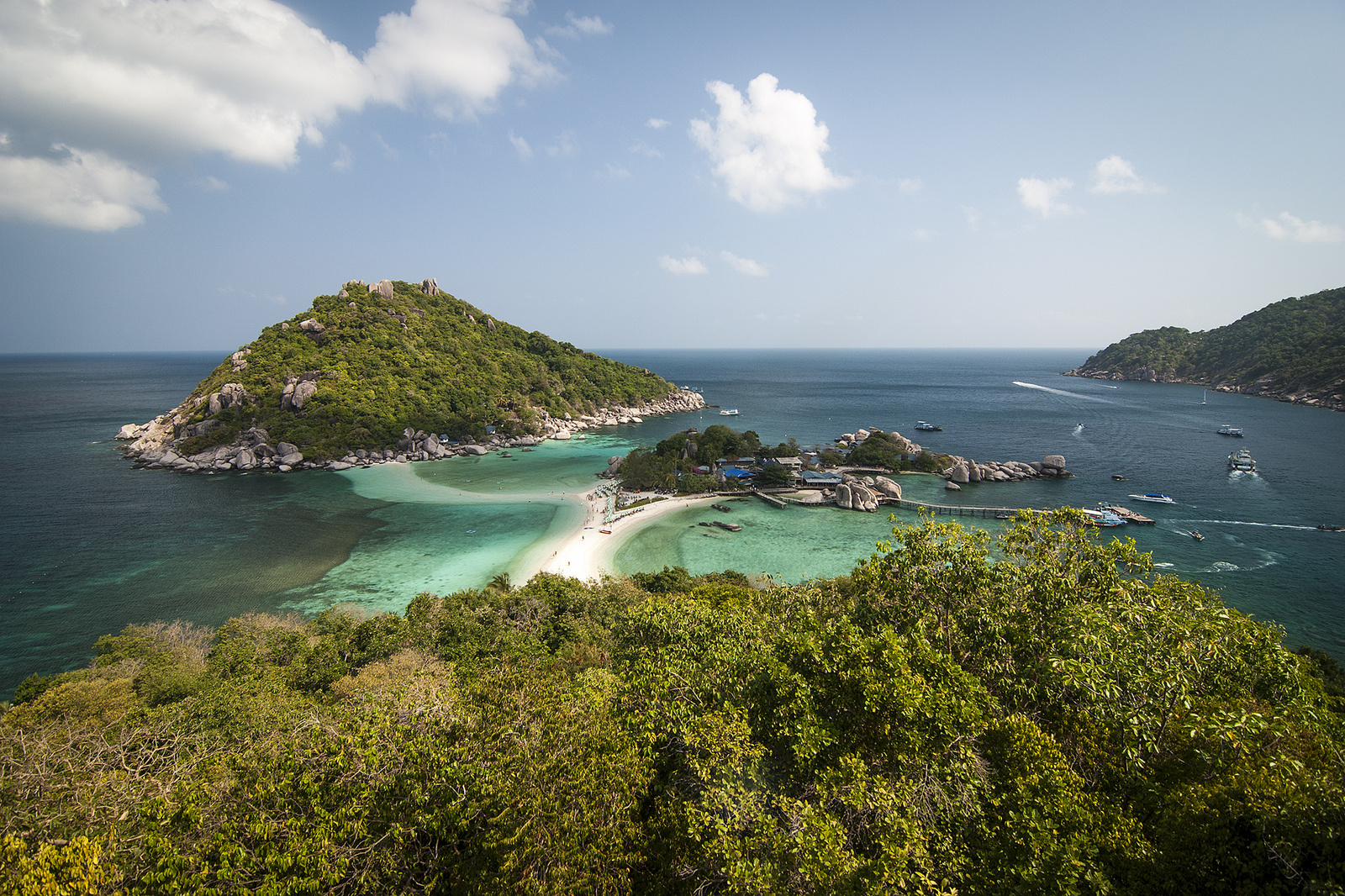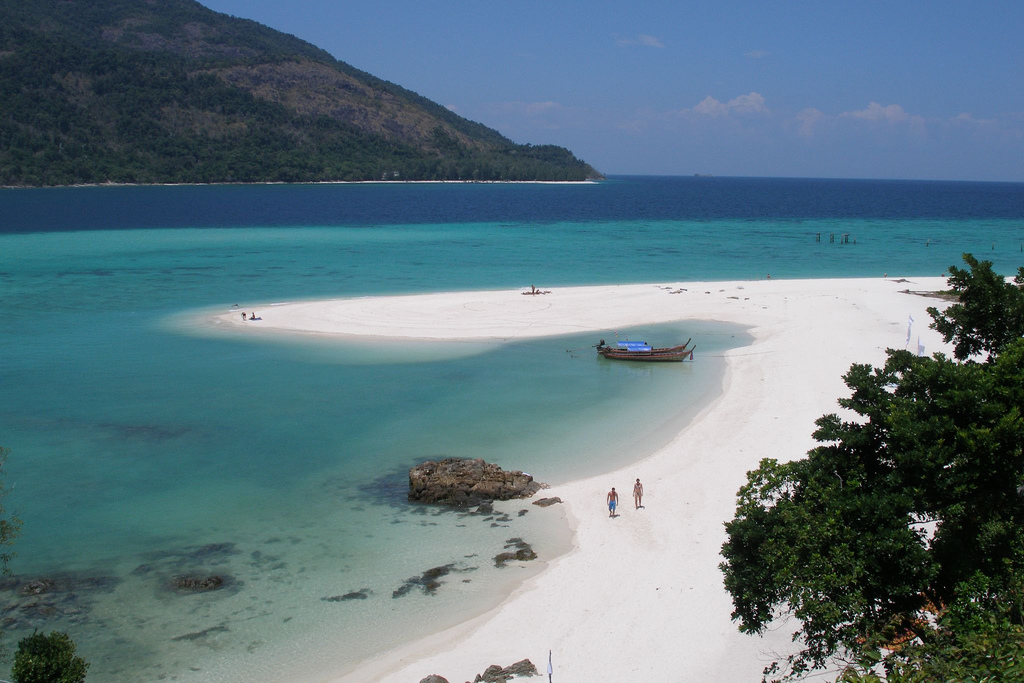The 20 Best Islands Of Thailand
Thailand is home to an astonishing array of islands offering all manner of diving, swimming and sunbathing opportunities all year round. The hardest part for any visitor is singling out the best. Here are 20 of our favourites. Scroll down and click the link to see them placed geographically on our interactive map.
Koh Chang
Edged with a chain of long, mostly white-sand beaches and dominated by a broad central spine of jungle-clad hills, Koh Chang is developing fast but still feels green. It’s Thailand’s second largest island, after Phuket, but unlike its bigger sister it has no villages or tourist facilities within its steeply contoured and densely forested interior, just a few rivers, waterfalls and hiking trails. Despite its popularity with mainstream and package tourists, it’s still possible to find accommodation to suit most budgets and though the beaches may be busy, they’re undeniably handsome with plenty of inviting places to swim, stroll or snooze under a palm tree.
Koh Si Chang
The unhurried pace and absence of consumer pressures make tiny, rocky Koh Si Chang an engaging place to wind down for a few days. Unlike most other east coast destinations, it offers no real beach life – though the water can be beautifully clear and there are opportunities to dive and snorkel. There’s little to do here but explore the craggy coastline by kayak or ramble up and down the steep contours on foot or by motorbike.
Koh Pha Ngan
For drinking and dancing – and then more dancing – Koh Pha Ngan gets a mention in this list thanks to its world famous beach, Hat Rin. It’s now established as the major party venue in Southeast Asia, especially in the peak seasons of August, December and January, but every month of the year people flock in for the infamous Full Moon Party. The atmosphere created by thousands of folk mashing it up on the beautiful, moon-bathed beach, lit up by fireworks and fire jugglers, ought to be enough of a buzz in itself, but unfortunately drug related horror stories are common currency here, and many of them are true, so be careful.
Koh Samet
Blessed with the softest, squeakiest sand within weekending distance of Bangkok, the tiny island of Koh Samet, which measures just six kilometres from top to toe, is a favourite escape for Thais, expats and tourists. Its 14 small but dazzlingly white beaches are breathtakingly beautiful, lapped by pale blue water and in places still shaded by coconut palms and the occasional cajeput (samet) tree that gave the island its name. They are also, however, rather overcrowded and developed to full capacity, so don’t come here expecting a secluded break.
Koh Mak
Small, slow-paced, peaceful Koh Mak makes an idyllically low-key alternative to Koh Chang. Home to little more than 400 people, many of them descended from the islands’ five main clans, Koh Mak measures just 16 square kilometres and is dominated by coconut and rubber plantations. The island is shaped like a star and has fine white-sand beaches where most of the tourist accommodation is concentrated.
Koh Kood
The fourth-larges island in Thailand, forested Koh Kood (sometimes spelt Koh Kut or Koh Kud) is still a wild and largely uncommercialized island. Though it’s known for its sparkling white sand and exceptionally clear turquoise water, particularly along the west coast, Koh Kood is as much a nature lover’s destination as a beach bum’s. Swathes of shoreline are fringed by scrub and mangrove rather than broad sandy beaches and those parts of the island not still covered in virgin tropical rainforest are filled with palm groves and rubber plantations. Koh Kood is a surprisingly pleasant place to explore on foot (or kayak), especially as the cool season brings refreshing breezes most days.
Koh Tao
Koh Tao (Turtle Island) is so named because its outline resembles a turtle nosediving towards Koh Pha Ngan, 40km to the south. The rugged shell of the turtle, to the east, is crenellated with secluded coves where one or two bungalows hide among the rocks. On the western side, the turtle’s underbelly is a long curve of classic beach, Hat Sai Ree, and the 21 squared kilometres of granite in between is topped by dense forest on the higher slopes and dotted with huge boulders that look as if they await some Easter Island sculptor. There are rough trails inland that are great for exploring but Koh Tao is most famous for its great scuba diving.
Koh Chang (Andaman Coast)
No, we’re not repeating ourselves, this is a different Koh Chang, not to be confused with its much larger namesake off the east coast of Thailand. It’s a forested little island about 5km offshore, whose car-free, ultra laid-back, roll-your-own vibe more than compensates for the less-than-perfect beaches. The pace of life here is very slow and for the relatively small number of tourists who make it to the island the emphasis is strongly on kicking back and chilling out – bring your own hammock and you’ll fit right in.
Koh Phayam
The diminutive kangaroo-shaped island of Koh Phayam offers fine white-sand beaches and coral reefs and is home to around 500 people, most of whom either make their living from prawn, squid or crab fishing, or from growing cashew nuts, sator beans, coconut palms and rubber trees. Because of its roads, Koh Phayam has a slightly more developed feel than neighbouring Koh Chang, underlined by a low-key beach-bar scene – all hand-painted signs and driftwood sculptures – and the presences of a significant number of foreigners who choose to spend six or more months here every year.
Koh Ra
Hilly, forested Koh Ra (measuring about 10km north to south and 3km across) sits just off Khuraburi pier’s mangrove-lined estuary and is covered with intact rainforest full of towering trees, hornbills and wild, empty beaches. The island is home to some two-dozen Moken and Mai Tai people and just one place to stay, the rather special American-Thai run Koh Ra Ecolodge.
Mu Koh Surin National Park
Spectacularly varied and unusually shallow reefs, a palette of awesomely clear turquoise waters and dazzling white sands, and dense forests of lofty dipterocarps combine to make the islands of Mu Koh Surin National Park one of the must-visit destinations in south Thailand. It’s very much an outdoors experience, with most of the bulk of accommodation in national park tents, no commerce on the island at all, and twice-daily snorkelling the main activity.
Mu Koh Similan National Park
Rated as one of the world’s best spots for both above-water and underwater beauty, the eleven islands at the heart of the Mu Koh Similan National Park are among the most exciting diving destinations in Thailand. Massive granite boulders set magnificently against the turquoise waters give the islands their distinctive character, but it’s the thirty-metre visibility that draws the divers. The underwater scenery is nothing short of overwhelming here: the reefs teem with coral fish, and you’ll see turtles, manta rays, moray eels, sea snakes, red grouper and possibly white tip sharks, barracuda, giant lobster and enormous tuna.
Koh Jum
This is the sort of laidback spot people come to for a couple of days, then can’t bring themselves to leave. Though there’s plenty of accommodation on the island, there’s nothing more than a handful of beach bars for evening entertainment, and little to do during the day except try out the half-dozen west coast beaches and read your book under a tree. Nights are low key: it’s paraffin lamps and starlight after 11pm at places off the main grid and many don’t even provide fans as ocean breezes are sufficiently cooling.
Koh Yao Noi
Located in an idyllic spot on the edge of Phang Nga bay, almost equidistant from Phuket, Phang Nga and Krabi, the island of Koh Yao Noi enjoys magnificent maritime views from almost every angle and makes a refreshingly tranquil getaway. Measuring about 12km at its longest point, it’s home to some four thousand islanders, most of whom earn their living from rubber and coconut plantations, fishing and shrimp-farming. While the beaches don’t have that same wow factor as many of the other islands in Thailand, tourism here is low-key so it’s a peaceful escape.
Koh Lanta Yai
Although Koh Lanta Yai can’t compete with neighbouring Koh Phi Phi’s stupendous scenery, the thickly forested 25-kilometre-long island has the longest beaches in the Krabi area – and plenty of them. There’s good snorkelling and diving nearby, plus caves to explore, elephant trekking and kayaking, so many people base themselves here for their entire holiday fortnight. The island is especially popular with families, in part because of the local laws that have so far prevented jet-skis, beachfront parasols and girlie bars from turning it into another Phuket.
Koh Hai
The most developed of the Trang islands, Koh Hai (also known as Koh Ngai) is still decidedly low-key. The island’s action, such as it is, centres on the east coast, where half a dozen resorts enjoy a dreamy panorama of jagged limestone outcrops, whose crags glow pink and blue against the setting sun, stretching across the sea to the mainland behind. The gently sloping, fine white sand beach here runs unbroken for 2km and there’s some good snorkelling in the shallow, clear water off the island’s southeastern tip.
Koh Kradan
Koh Kradan is the remotest of the inhabited islands off Trang, and one of the most beautiful, with crystal clear waters. On this slender triangle of thick jungle, the main beach is a long strand of steeply sloping, powdery sand on the east coast with fine views of Koh Mook, Koh Libong and the karst-strewn mainland. An offshore reef to the north has a great variety of hard coral. Such beauty, however, has not escaped the attention of day-trip boats from Koh Lanta who often turn the beach into a lunchtime picnic ground.
Koh Sukorn
Further south than the other Trang islands, low-lying Koh Sukorn lacks the white-sand beaches and beautiful coral of its neighbours but makes up for it with friendly inhabitants, laid-back ambience and one excellent resort; for a glimpse of how the islanders live and work, this is the place to come. The lush interior is mainly given over to rubber plantations, interspersed with rice paddies, banana and coconut palms; the island also produces famously delicious watermelons.
Koh Turatao
This is the largest of the Koh Turatao National Park archipelago and it offers the greatest natural variety: mountains covered in semi-evergreen rainforest rise steeply to a high point of 700m; limestone caves and mangrove swamps dot the shoreline; and the west coast is lined with perfect beaches for most of its 26-kilometre length.
Koh Adang
This wild, rugged island is covered in tropical rainforest and the beach is steep and narrow and backed by a thick canopy of pines. There’s a steep half-hour climb to Sha-do cliff that’s worth tackling as it gives way to great views over Koh Lipe island to the south, while about 2km west along the coast from the main park station, a 20-minute trail leads inland to the small Pirate Waterfall.
By Site Editor
August 19th, 2013
www.roughguides.com
Island Hopping South Thailand


